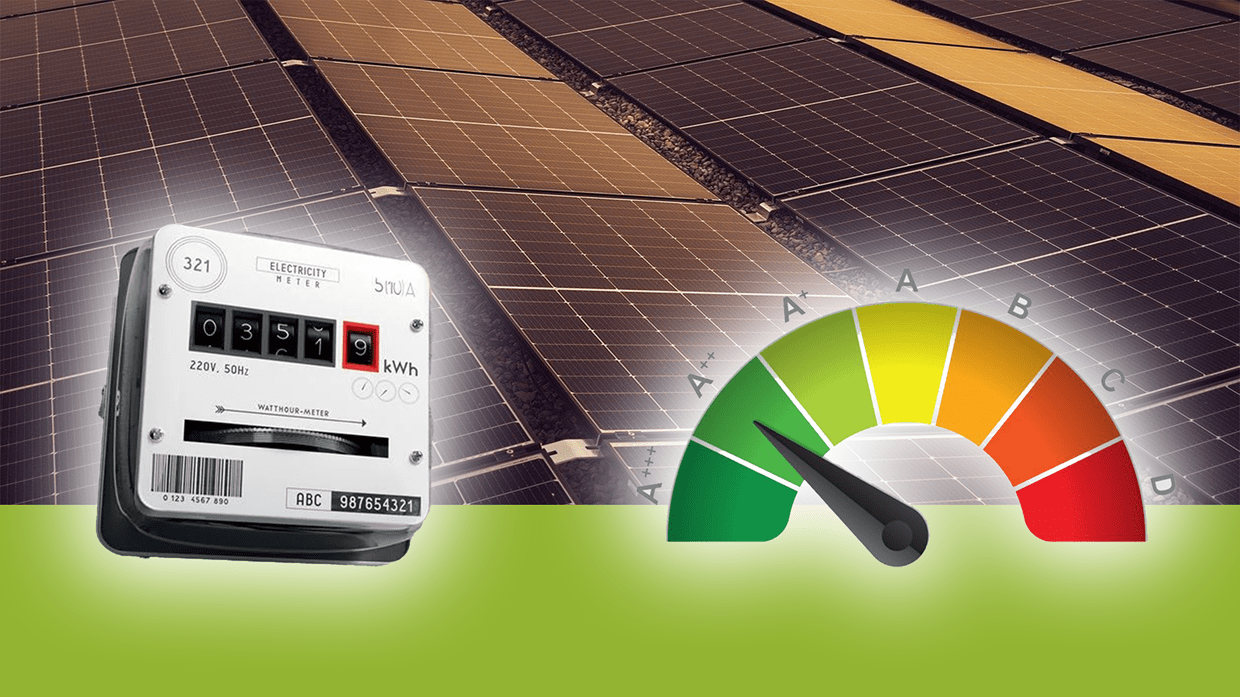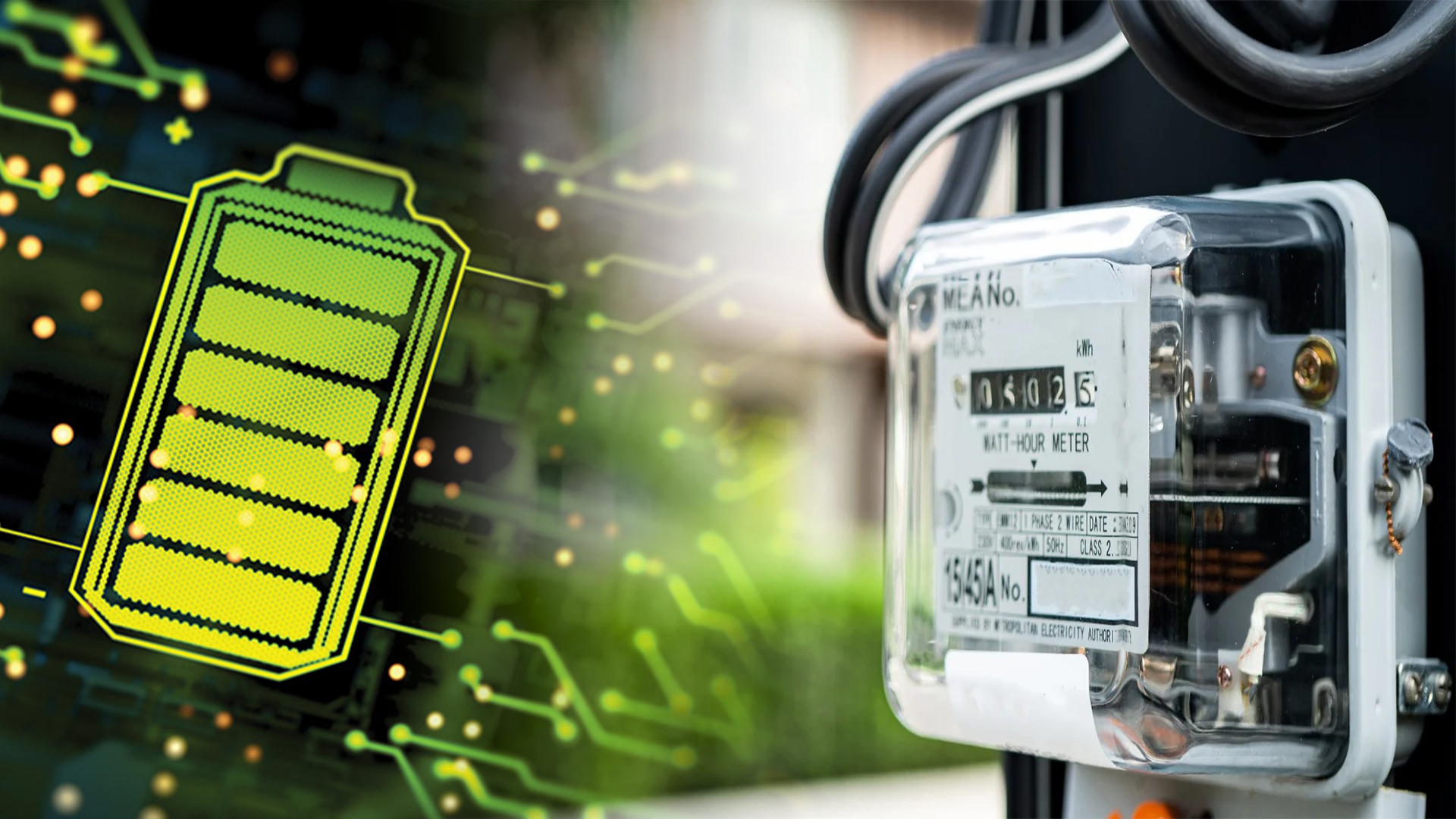- Updated On: February 30, 2024
What’s the Difference Between a Kilowatt and a Kilowatt-Hour?

While diving into the world of solar energy, two terms you’ll frequently encounter are kilowatt (kW) and kilowatt-hour (kWh). These units of measurement are essential to understanding how photovoltaics work and how to size a solar panel system for a home or business. Let’s break these concepts down to help you better understand how a solar power system works and what it does.
What is a kilowatt?
A kW is a unit of power that we ascribe to electricity’s ability to do work. It’s equivalent to 1,000 watts (W). It’s used both to describe how much power a device will use (like a 1500 W hair dryer) or produce (like a 320 W solar panel).
Why it matters to solar installations:
The amount of power a solar panel can produce is measured in watts and solar installations, whether on a roof or ground-mounted, are generally measured in kWs and even megawatts (Mws). A 15-panel residential rooftop system made of 320 W panels is a 4.8 kW solar installation.
What is a kilowatt-hour?
A kWh is a measure of energy that represents the amount of electrical power consumed or produced over a given period. One kWh is equivalent to the quantity of energy utilized when an appliance rated at 1,000 watts operates for one hour.
Why it matters to solar installations:
When discussing the amount of energy a solar system produces, it’s measured in kWhs. Solar systems are rated by the amount of energy they can produce in terms of kWhs. Operating during peak sun (when the sun is at its highest point in the sky on a cloudless day) the 4.8 kW should be able to produce 4.8kWhs of energy.
That’s enough to power three 1500 W hair dryers for an hour. Additionally, it can power some LED bulbs and other small electronics. While a solar array will perform at its peak for hours some days, it will perform at less than peak on days that are cloudy or when the days are shorter.

Why Both Matter When Planning a Solar Installation
- Understanding your energy usage: The first step in planning what size solar installation you need is getting an idea of how much energy you use. This is done by measuring how many kWhs you consume in a year and how much your electric bill is.
- System sizing: Knowing how much roof (or ground) area you have that is ideal for solar panels, gives you an idea of how many kWs of solar panels you can install to replace some or all of the power you get from the electric grid.
- Solar system production: Knowing the size of your system in kWs helps you get an idea of much energy your system could produce. However, there are multiple other things that factor into how much energy your system will produce including location and anticipated days of sunlight a year.
How Kilowatts and Kilowatt-Hours Come Into Play in a Solar Array
In designing a solar system and putting one into service both kWs and kWhs play an important role. The kWs of a solar array represent its potential, as do the anticipated kWhs it should produce annually. However, the actual kWhs will vary slightly year to year.
A system is designed based on the amount of electricity each panel in a solar system can capture and turn into electricity under ideal conditions. Hence, a system with 20 panels that each are rated at 400 watts, could produce 8 kWs an hour under ideal conditions. Otherwise written as 8 kWhs.
As mentioned earlier, location and weather also play an important part. A solar installation in an area with 7 or 8 peak hours of sun on average, like Arizona, will produce more than one in an area that only has 4.5 peak sun hours, like parts of Delaware. The solar system in Delaware will still produce electricity, just not as much as the one in Arizona will.
If you had two homes, one in Delaware and one in Arizona, that used the same amount of energy you could install solar on both of them. But for the solar power to replace all the power needed in the home in Delaware, you’d need more solar panels to produce enough kWhs.
How are Kilowatt Costs Different from Kilowatt Hour Costs
When you’re buying a solar system, you’re buying the kWs of the panels. Without incentives that reduce the cost of solar panels in the US. The average cost per watt for a residential solar system in the US is about $3.50 per watt in 2024, before incentives, according to the Solar Energy Industries Association (SEIA). That means an average 6 kW solar installation would cost about $21,000 before incentives like the 30% Investment Tax Credit (ITC) bring the costs down. The ITC alone will make that same system cost just $14,700, state and local incentives will bring the cost down even more.
The average cost of electricity in the US in 2024 is about $0.159 per kWh, the US Energy Information Administration says. It also says the average US home uses almost 10,800 kWhs per year, meaning the average homeowner pays about $1,700 in electric bills a year.

The average 6 kW solar system in the US can produce between 8,000 and 10,000 kWhs yearly, according to EcoWatch. So, with some “back of the napkin math” the $14,700 invested in a solar system would generate enough electricity. Consequently, it pays for itself in about 10 years, or less with local incentives like net metering, rebates and tax breaks. After that, the energy it produces for the next 15 years reduces your overall electric bills.
FAQS:
1. Are 1 kW and 1 kWh the same?
No. One kW and 1 kWh are not the same thing. Consider 1 kW as the power a device could use or produce energy. While a kWh is the actual use of that energy over time.
In equation form it would be:
Energy (kWh) = Power (kW) × time (hours)
2. How many solar panels is 1 kW?
The wattage of residential solar panels is between 320 and 400 watts per panel, depending on the panel’s wattage rating. Therefore you would need 3 to 5 solar panels to reach 1 kW of power.
3. How does the kW rating of a solar system affect its performance?
The rating of the kW of a solar system is the maximum power output that it can produce under ideal conditions, like in a lab simulating sunlight. The more kWs, the more kWhs it can produce. However, the total amount of energy produced is dependent on factors like sunlight’s availability, the panel’s orientation, and geographic location.
4. Why are kWhs important for my electric bill?
Your electric bill is determined by the amount of energy you consume, which is calculated based on the kWhs of energy you use in a given period. Typically, this period is a month.
5. Can weather affect my solar system’s kWh production?
Yes. The weather can have a significant impact on your solar system’s total energy production. Here are some ways it impacts it:
- Sunlight: Solar panels utilize sunlight to produce energy. More consistent and longer daylight hours lead to higher production of kWhs.
- Temperature: The efficiency of solar panels are impacted slightly by changes in temperature. At lower temperatures they produce slightly more than at higher temperatures.
- Clouds and rain: Overcast skies and precipitation decrease the amount of sunlight that hits the panels. Consequently, reducing their ability to produce electricity.
We hope this helps you understand the differences between kilowatts and kilowatt-hours and how they relate to solar power installations. To learn more about how solar can reduce your energy costs and power your house, contact SolarSME for an estimate of how much a system will cost you.
Related Articles:
A home energy assessment allows you to get insights into your home's power usage, comfort, and safety. In this article, we will guide you through everything you should know about these audits, the process, and when you should consider it.
In recent years, the solar energy trend is booming in the U.S. due to its long-term benefits including low energy bills, grid independence, and environment-friendliness.
Tesla solar shingles may seem visually appealing, but it is essential to consider the pros and cons, Tesla roof tile costs, etc., according to your energy goals. We will compare solar roofs with solar panels to help you make a smart decision for your home.



